
This guide answers typical questions encountered by Lutron's Technical Assistance and Applications personnel concerning low-voltage dimming applications. Lutron manufactures low-voltage dimmers for lowvoltage fixtures that use magnetic transformers.
To control electronic (solid-state) transformer-supplied low-voltage lighting, Lutron developed special dimming circuitry after an extensive engineering research and development program. This technology has been built into a Series of dimmers specifically for ELV transformer loads.
Lutron offers dimmers for both load types in a variety of product families.
Low-voltage lighting uses a transformer to reduce a 120VAC line voltage to 12VAC or 24VAC. This lower voltage is then used to power an incandescent lowvoltage lamp. Examples of low-voltage lamps are AR111, MR16, MR11, PAR36, T3-1/4, T5, striplites, etc. Many, but not all low-voltage lamps are tungsten halogen.
A low-voltage transformer may be mounted remotely or as an integral part of the fixture.
Dimming will increase the life expectancy of low-voltage lamps. Occasionally, darkening of a low-voltage halogen lamp may occur. If this happens, simply turn on the lamp at 100% illumination for 10 minutes and the black residue (the result of tungsten evaporation) will nearly be eliminated.
When dimming a low-voltage fixture, the dimmer controls the line voltage (120VAC) input to the transformer powering the low-voltage lamps. There are two types of transformers manufactured for low-voltage lighting:
Important: Before selecting a dimmer, determine what type of transformer is in the lighting fixture. Different characteristics of the two transformer types require special dimming considerations. If you have a question concerning what type of transformer a fixture uses, refer to the fixture manufacturer's literature. Note: Line voltage incandescent and low-voltage fixtures can be mixed on the same circuit, but the correct low-voltage dimmer (for the given low-voltage load) must be used. The total load must not exceed the dimmers capacity. Do not mix magnetic and electronic transformers on the same dimming circuit. Note: Some low-voltage fixtures cannot be dimmed.
Read the literature from the fixture manufacturer for details.
Magnetic transformers step down 120VAC line voltage 12VAC or 24VAC. Magnetic transformers use copper, wound around a steel core which is inductive by nature inductance is the ability of a device to store energy in form of a magnetic field). Magnetic transformers are relatively large and heavy. Magnetic transformers are primarily available in two types of construction; torroidal and laminiated EI core. For these types of transformers, use one of Lutron's magnetic low-voltage dimmers. These products are rated in volt-ampere (VA), which is explained in Dimming Magnetic Transformers below. MLV transformers should be equipped with a primary fuse to protect against over heating.
Electronic transformers also step down 120VAC line voltage to 12VAC or 24VAC. This is done with electronic circuitry which is capacitive by nature capacitance is the ability of a device to store energy in form of an electric field). Electronic transformers are compact and lightweight. Due to the higher efficiency of ELV transformers, Lutron ELV dimmers are rated in watts, which is the lamp load connected to the transformer.
Dimmers for use with magnetic low-voltage transformers use a technology known as standard phase control or "leading edge," where as dimmers for electronic lowvoltage transformers use reverse phase control or "trailing edge." Standard phase control is for use with either inductive (MLV transformers, fans) or resistive (incandescent) loads. Reverse phase control is for use with either capacitive (ELV transformers) or resistive (incandescent) load types.

Reverse phase control or "trailing edge"
With reverse phase control, the dimmer starts to provide power immediately after the zero cross. Dimming is achieved by delaying the time at which the dimmer stops conducting.

Standard phase control or "leading edge"
With standard phase control, the dimmer does not provide power until sometime later into the line cycle. Once the dimmer starts to provide power, it will do so until the zero cross. Dimming is achieved by delaying the time at which the dimmer starts conducting.
Magnetic transformers are inductive loads and are sensitive to DC voltages. A magnetic transformer subjected to DC voltage can overheat.
Do not use regular incandescent dimmers for magnetic low-voltage lighting. Regular incandescent dimmers often contain a small amount of DC voltage, which is harmless to a regular incandescent load but may damage magnetic transformers. Lutron MLV dimmers are specifically designed to prevent DC voltage from being applied to the transformer.
Certain MLV transformers may not be compatible with all Lutron dimmers. MLV transformers with built-in input chokes or "debuzzing coils" may not be compatible with certain microprocessor based dimmers. In order to address this compatibility, Lutron offers microprocessor dimmers with a neutral connection. Check with Lutron's Customer Service or your local Lutron representative for availability. These transformers should be compatible with standard (non-microprocessor) two wire controls such as Diva®, Nova T ® and Skylark®.
Some MLV transformers have secondary side protection such as PTC, fuses, circuit breakers or in some cases an electronic overload/fault detection circuit. In almost all cases PTCs, fuses and circuit breakers are compatible with Lutron dimmers. Check with the Lutron Technical Support Center for compatibility, especially with MLV transformers equipped with electronic overload/fault detection circuits.
A dimmer controlling an inductive load such as a magnetic transformer is also subjected to large voltage spikes and current surges. Lutron magnetic low-voltage dimmers are designed to withstand these spikes and surges.
The stated VA (volt-ampere) rating is the rated capacity of the magnetic low-voltage dimmer. The wattage rating is provided only as a reference and indicates the lamp wattage that can be placed on a UL approved (80% efficient) magnetic low-voltage transformer without exceeding the dimmer's VA rating.

Typical wiring for magnetic low-voltage dimmers.
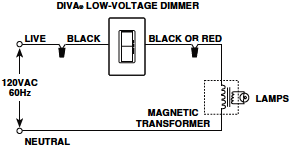
Wiring for a Nova® magnetic low-voltage dimmer (NLV- 600, NLV-1000, NLV-1500). Note that only the Nova® single pole, slide-to-off Series requires a neutral wire.
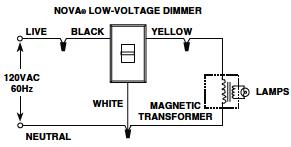
Lutron's electronic low-voltage dimmers are designed specifically for the special electrical requirements of electronic transformers. The electrical characteristics of an electronic transformer are capacitive (as opposed to an inductive magnetic transformer) and require special dimming considerations.
Do not use regular incandescent dimmers for electronic low-voltage lighting. When a magnetic lowvoltage or incandescent dimmer is used on electronic transformers, there is interaction between the fixture and the dimmer. This interaction will cause any combination of the following: dimmer buzz, fixture buzz, lamp flickering, interaction between circuits, Radio Frequency Interference (RFI) and may damage the dimmer or transformer. To eliminate these problems, use Lutron ELV (electronic low-voltage) dimmers.
Lutron's reverse phase control dimmers for ELV transformers do not expose the transformers to the sharp rise of voltage present in standard phase control (high dV/dT). High dV/dT of voltage can shorten the life of the components in the ELV transformer or create acoustic noise. Lutron's electronic low-voltage dimmers are UL listed for both ELV transformers and incandescent loads.
One advantage of using ELV dimmers on an incandescent load is that it can completely eliminate "AM" radio interference, but they do not provide any advantage at controlling lamp buzz. If you experience lamp buzz refer to Application Note #3.
While some electronic low-voltage transformers are labeled as "dimmable with standard incandescent dimmers" Lutron does not recommend this because the best dimming performance is achieved with Lutron ELV dimmers or GRAFIK Eye® system controls. While some GRAFIK Eye® systems use standard phase control for controlling ELV loads, but a large inductor is used to limit the rise time to the load and the system has a neutral connection for accurate zero cross information.
Lutron's ELV dimmers have overload protection. This protection reduces power to the lighting circuit when dimmer capacity is exceeded, thus preventing problems that could occur if the circuit is overloaded.
Typical wiring for electronic low-voltage dimmers. Note: All electronic low-voltage dimmers require a neutral wire.
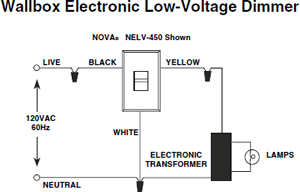
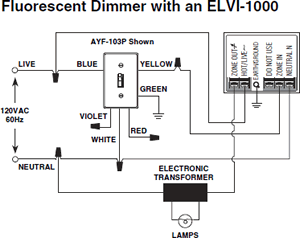
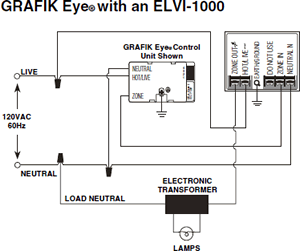

design42 New Media Web Design
1804 Meadowbrook Terrace
Hendersonville NC 28791